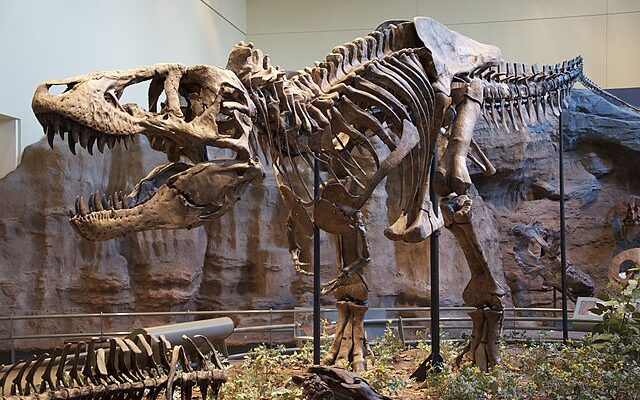
The mighty Tyrannosaurus rex, often hailed as the undisputed king of the dinosaurs, ruled the Late Cretaceous period with unparalleled dominance and ferocity. Towering over its contemporaries, this colossal carnivore stood on two powerful hind limbs, boasting a height that could reach up to 20 feet at the hips. Its massive skull, armed with rows of formidable serrated teeth, was a fearsome weapon designed for crushing bones and tearing through flesh. T. rex’s keen sense of smell and binocular vision made it a formidable predator, capable of tracking down prey with precision.
With a weight that could exceed nine tons, T. rex was a true apex predator, instilling fear in the hearts of any creature that crossed its path. Its iconic image has become synonymous with the notion of a prehistoric ruler, showcasing not only the sheer might of this incredible dinosaur but also its enduring legacy in popular culture. The legacy of T. rex as the ultimate king of the dinosaurs endures, captivating the imaginations of scientists and enthusiasts alike, as they continue to uncover the mysteries surrounding this magnificent and awe-inspiring creature from the ancient past.
Now, researchers believe they have found grandparents.
Paleontologists have discovered a new species of dinosaur that could be the closest-known relative of the famed Tyrannosaurus rex, writes ABC News.
The jaw of the dinosaur was found in 1983 by civilians boating in the Elephant Butte reservoir in Las Cruces, New Mexico, Spencer Lucas, curator of paleontology at the New Mexico Museum of Natural History and Science, told ABC News. After boaters alerted the museum to their finding, a subsequent search of the area by paleontologists uncovered additional dinosaur bones, and another dig in the 1990s led to the findings of even more, Lucas said.
The scientists initially assumed that the fossils they found, the jaw and part of the skull, belonged to Tyrannosaurus rex, the famed large theropod dinosaur that existed 66 million to 68 million years ago during the Late Cretaceous period. But in the last 20 years, further study of the jaw indicated that it was a new species entirely, Lucas said.
The general shape of the jaw of the new species of Tyrannosaurus is similar to the T. rex, but there are two key components in which they are different, Anthony Fiorillo, executive director of New Mexico Museum of Natural History and Science, told ABC News. The jaw of the Tyrannosaurus mcraeensis is much more slender than what you see in the robust lower jaw of the T. rex, which implies a different way of processing food, Fiorillo said.
Smithsonian Magazine noted that “despite the popular interest in these fierce predators, scientists are unsure where T. rex originated. Paleontologists haven’t dug up any of its close relatives in North America from the time before the species appeared, the study authors write. But T. mcraeensis, as a potential relative of T. rex, could shed light on this question.
Historically, however, the subject of tyrannosaur species has been controversial among scientists. A 2022 paper, for example, suggested that T. rex should be split into three separate species—and this proposal was so disputed that another group of researchers published a rebuttal paper months later. Other experts have spent decades debating whether a certain group of fossils represent T. rex juveniles or another dinosaur entirely.
The reexamined bones also predate T. rex by several million years. Based on the part of the fossil record its remains were found in, T. mcraeensis might have been alive between 70.9 and 72.7 million years ago.”
Maybe they found the ancestor of the King of the Dinosaurs instead.









